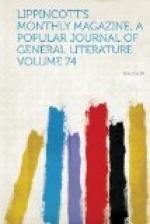About fifteen miles up and down brought us to our first ranch, on Pole Creek, a dry stream, with osiers, shrubs and weeds in its bed. It was pleasant to see something green, even so little, and something human, though only a long, low whitewashed cabin; but this touch of life did not make much impression upon the wilderness, save to make it seem wilder. A plover was flying about, “crying and calling:” a large flock of cow-buntings, our old acquaintances, followed the cattle that grazed in the bed of the stream. We gathered twenty species of flowers here, among them a tiny scarlet mallow and a white oenothera or evening primrose. In the three rooms of the ranch there was refreshment to be found, doubtless of a spirituous nature, but we watered our mules and went on. It was ten miles farther before we came to our next ranch, so thinly settled is the country. Being time for our noonday rest, we took refuge from the fierce heat and glare of the desert in the clean rooms of Mrs. Fagin, dined on our own provisions and drank the excellent milk she brought us.
Still on the ambulances rolled, over the hot, high table-land, till about five o’clock we saw some strange yellow bluffs before us, and descended into the valley of the Chug, a clear stream flowing through a fringe of willow, box-elder (a species of maple) and the cottonwood poplar. Here was Kelly’s Ranch, a large one, close by which we were to camp for the night. We found there Lieutenant F—— and an escort of twenty horse, which had been sent to meet us from Fort Laramie. They had our tents pitched for us, and everything ready. A wild, lonely place was this green valley, with its fantastic waterworn bluffs that bore a grotesque resemblance to turtles, seals and other great sea-beasts, and it was delightful to see trees again and to hear the sound of running water. The children at once pulled off shoes and stockings and began to paddle in the stream, and some of the elders followed. It was arranged that we should have supper and breakfast in the ranch, which was a sort of tavern, and we found the supper quite good enough for hungry people, despite the odor of onions that pervades the hearths and homes of this region.




